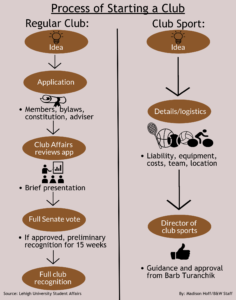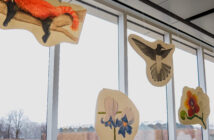 There are more than 175 clubs at Lehigh.
There are more than 175 clubs at Lehigh.
Clubs range from University Productions to Habitat for Humanity to Latin Dance Club, while club sports range from gymnastics to snowboarding and skiing. If a club or a club sport doesn’t exist, students can go through an application process to create one.
“It takes an idea, a small group of interested and motivated people, and interest of the campus community to start a club,” said Gordon Gorab, ’20, chair of the club affairs committee for Student Senate.
The process of club recognition involves planning and organizing to gain acknowledgment. Potential creators must first access the club application online through LINC.
“Components of the application include members of the executive board (and) a faculty adviser,” Gorab said. “They have to create bylaws, a constitution of their own. That’s all on the application I receive when they fill it out.”
According to Senate’s website, after the form is received, a meeting is held for the club founders to give a five- to 10-minute presentation about their proposal.
Connor Cragon, ’19, the president of Lehigh’s Got Talent, went through this process in spring 2016 to bring his own idea to fruition.
“When you’re pitching to Student Senate, they want to see that you’ve got a lot of interest, not only club members,” Cragon said. “It’s good to have a list or a number of people who have said, ‘Yes, this is a good idea on campus, I would go to your events.'”
Ileana Exaras, ’18, who is organizing the European Union Club, is going through the approval process now.
She said some difficulties while applying include delegating tasks among board members, adapting to the power dynamic and finding members who are serious about the idea and the club itself.
Gorab said Senate is looking to see how creators will promote its core goals and sustain membership after upperclassmen graduate.
Once a club is recommended by the club affairs committee and passes a full Senate vote, it becomes a preliminary club and receives a one-time funding allowance of $100.
Exaras said clubs must be actively planning during this start-up time.
“Clubs can change their status and go from preliminary to full recognition after a period of 15 academic weeks,” Gorab said, “which comes with the benefit of receiving an annual budget.”
Gorab said forming a new organization at Lehigh requires club hopefuls to be both passionate and realistic.
“You really need to step back and ask yourself if this is something that’s missing from campus and that needs to be on the campus,” Cragon said. “One of the ways you can find that out is just talking to your classmates.”
Organizations can reapply to be reconsidered if initially denied by Senate.
Besides clubs that are more interest- or idea-based, students can also start their own club sport.
According to the university club catalog, club sport teams are “formed when a group of students voluntarily organize in the aim of seeking structured and often competitive sport opportunities in an area of common interest.”
Although both types of organizations are considered clubs by the university, the steps to creating a club sport at Lehigh differ from the creation of other clubs, such as European Union Club or Lehigh’s Got Talent.
Rather than applying through Senate, students interested in starting a club sport work with Barb Turanchik, the director of club sports.
Turanchik said the club organizers must figure out how many undergraduate students are interested in playing, what type of equipment and gear they need, game and practice locations, opponents, and umpire and referee costs. They must also create a dues structure for the team and transportation.
“Sports are different than academic clubs because we’re looking at liability, we’re looking at risk, we’re looking at secondary insurance, we’re looking at catastrophic injury and we’re looking at a lot of travel with students supervising students,” said Jane Josephson, the director of intramural sports.
Josephson said financial commitments from team members, the need for continuous support from players and a lack of field space to host games are also considered when someone decides to begin a club sports team.
Turanchik said Lehigh only has varsity fields for athletic events and during the winter Rauch Fieldhouse is the only place for spring sports — like lacrosse — to practice, so scheduling is difficult for club teams.
“Sometimes (we) have to say no because we don’t have space to put you, nor do we have the supervision to supervise the events that want to happen,” Josephson said.
Josephson said students who want to start a club sport need to be diligent and plan out the logistics and contact Turanchik for guidance.
Cragon said beginning any new organization at Lehigh takes lots of commitment, but there is support throughout campus for those who are interested.





Comment policy
Comments posted to The Brown and White website are reviewed by a moderator before being approved. Incendiary speech or harassing language, including comments targeted at individuals, may be deemed unacceptable and not published. Spam and other soliciting will also be declined.
The Brown and White also reserves the right to not publish entirely anonymous comments.
1 Comment
Lehigh’s support of club sports is disgraceful. Club soccer is relegated to using a sloped grass field in horrible shape at the entrance to Goodman campus, even when the varsity fields aren’t being used. The nice grass practice fields behind Goodman Stadium, which apparently are reserved for area youth groups, are also off limits. Sorry, but for the tuition we pay, student club sports should take priority. There are plenty of fields and facilities available, Lehigh Athletics just won’t allow access to them by their own non-varsity students. The facilities at other schools used by club teams are generally artificial turf, even lighted. Embarrassing. Lehigh can certainly afford better for its own students!